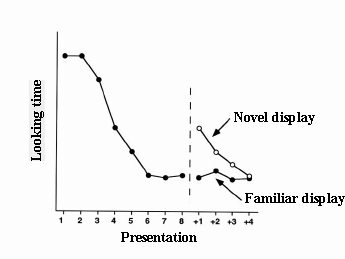A decrease in responding to the repeated presentation of a particular stimulus (see figure below). Habituation to a specific stimulus is generally believed to reflect the progressive encoding of that stimulus in memory and to be a simple form of learning.

A representation of habituation occurring to the repeated presentation of a visual display over 12 trials (1- to +4) during a visual preference looking experiment involving infants. The vertical dotted line indicates a new set of trials, when a novel display is introduced after the first 8 trials (1 to 8), and dishabituation of responding occurs across 4 trials (+1 to +4).
See Anencephaly, Encoding, Learning, Memory, Moderate-discrepancy hypothesis, Motion parallax, Novelty preference
